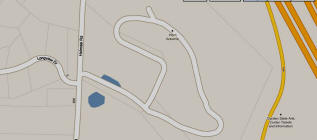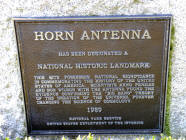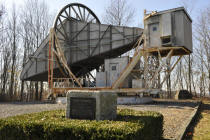


November 20, 2009. While shortwave listening one afternoon, I heard Amateur Radio Operator Stu AB2EZ mention that he was on a first name basis with two Nobel Prize winners who made history at Crawford Hill. It struck me that even though I live just 6 miles from the site, I never visited the place, so that was the basis for this trip.
Being a National Historic Landmark, one would expect to see road signs in the area but there were none. The location was found via a Google map and the road leading to the site was also unmarked, in fact, there is no indication of the site until you get to the top of the hill and actually see it. There is a Lucent (former AT&T) building next to the site which may be the reason for the stealth location? (Vacant as of April 2022).
The 20 foot horn was very well constructed by the Bell Telephone Laboratories and it shows what can be done with proper R&D funding.
The horn was moved by serious motorized equipment. The received signal was focused inside the "house" where the receiver and cooling equipment was located. The receiver front end was cooled to reduce the noise floor for critical measurements.
Behind the giant horn structure is a white building that must have contained the "read out" instrumentation based on the large conduits that run into the building from the horn.
The small white building in the foreground at right was the lubricant shed.
HISTORY
The supersensitive horn antenna system was built by Arthur B. Crawford of AT&T Bell Laboratories for Project Echo. The idea was to put a metalized reflecting balloon in space and test the feasibility of bouncing microwave telephone signals off the balloon. If this theory worked, then microwave satellites could be built and put in stationary orbit for reliable long distance communications. The project proved successful and the horn system was no longer needed by the laboratories.
Astronomers Arno A. Penzias and Robert W. Wilson of Bell Laboratories asked and received permission to use the horn antenna system for radio astronomy studies. While researching, Robert Wilson and Arno Penzias discovered a low-level noise signal that was heard in every direction of the sky and couldn't be eliminated. They thought that perhaps weather deterioration or bird droppings on the horn were causing the problem, so they had all parts of the horn system cleaned. While making precise measurements, the noise still persisted at an unexplained level of 3.5 degrees Kelvin. What these two gentlemen accidently discovered was Cosmic Microwave Background Radiation which was considered the best evidence for the Big Bang Theory. Their discovery was verified by researchers at Princeton University who were working on cosmic background radiation. In 1978 Bob Wilson and Arno Penzias received the Nobel Prize for their discovery.